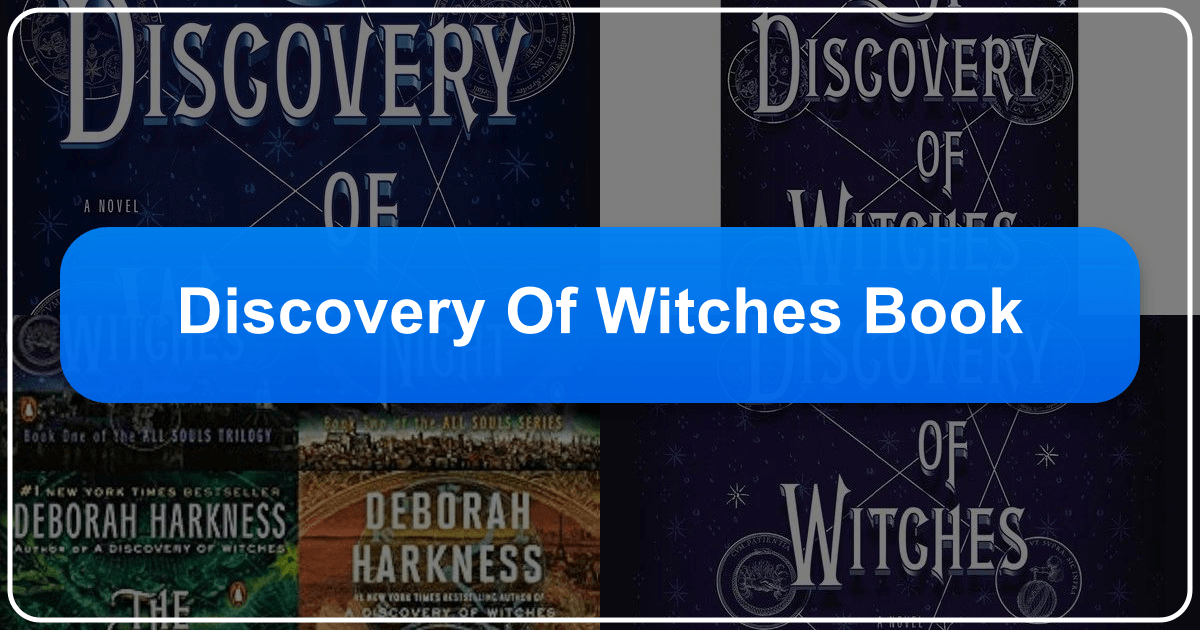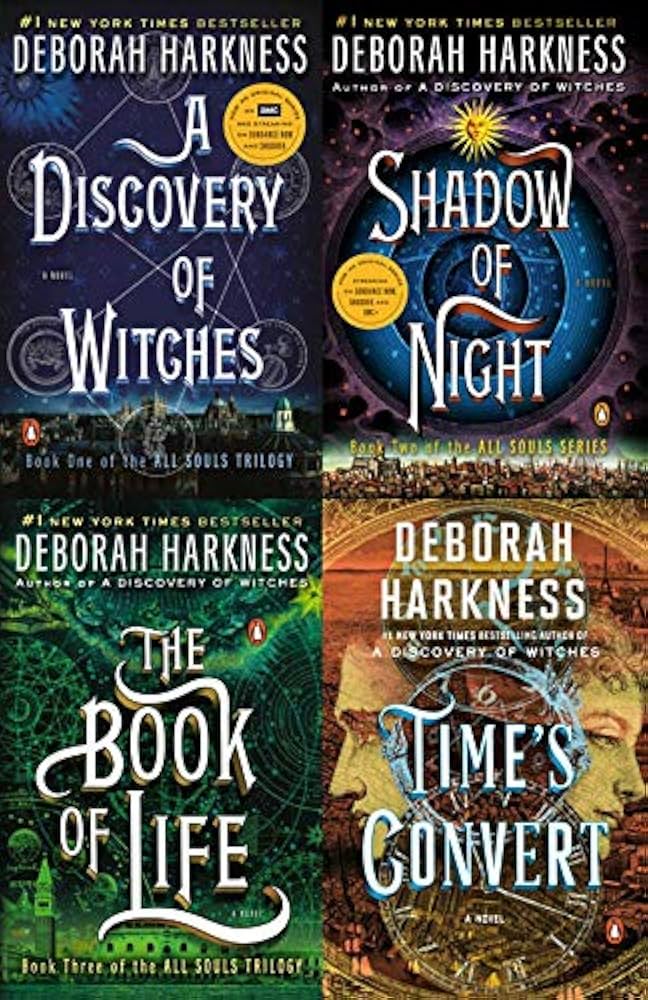A Discovery of Witches: A Deep Dive into Deborah Harkness's Spellbinding Novel

Deborah Harkness’s A Discovery of Witches, the captivating first book in the All Souls trilogy, has captivated readers worldwide with its blend of historical fiction, romance, and fantasy. This article delves into the novel’s multifaceted aspects, exploring its genre, characters, themes, and cultural impact, using a framework inspired by a typical book review website.
Genre and Literary Classification
A Discovery of Witches defies easy categorization, blending several popular genres seamlessly. While primarily classified as paranormal romance, its strong historical underpinnings and elements of mystery and suspense elevate it beyond a typical romance novel. The book draws heavily from historical research, particularly in its depiction of alchemy and the world of scholars in Oxford. This historical detail gives it a depth and authenticity often lacking in purely fantasy or paranormal romances, making it appeal to readers who enjoy both historical fiction and genre fiction. The romantic element, a forbidden love affair between a witch and a vampire, is central to the plot but doesn’t overshadow the other narrative strands, allowing the book to engage a broad audience interested in diverse literary experiences. The book’s elements of mystery surrounding the Ashmole 782 manuscript and the broader conflict between supernatural beings add to its suspenseful nature, making it an intriguing read for fans of mystery novels as well. In short, it is a unique tapestry woven from the threads of historical fiction, paranormal romance, mystery, and fantasy.
Bestseller Status and Critical Reception
Since its publication, A Discovery of Witches has achieved significant bestseller status, demonstrating its widespread popularity and critical acclaim. However, reviews have been mixed, highlighting a discrepancy between popular reception and some criticisms of the narrative. While many praise its rich world-building and engaging characters, some criticize the pacing, the length, and aspects of the central romance. The overwhelmingly positive response of many readers suggests that the book’s unique appeal resonates with its target audience despite critical reservations from some reviewers.

Character Analysis and Relationship Dynamics
The novel centers around Diana Bishop, a reluctant witch and history professor at Yale University, who accidentally summons a powerful magical manuscript. Diana’s character is complex; she initially avoids using her magical abilities due to the traumatic loss of her parents, but gradually embraces her heritage and powers. This arc appeals to many readers. The character’s intellectual strengths and independent nature are balanced with vulnerability and emotional growth.
Diana’s romantic entanglement with Matthew Clairmont, a centuries-old vampire and geneticist, is a significant aspect of the narrative. Their relationship, however, is a source of both praise and criticism. While some admire the intensity and forbidden nature of their connection, others find Matthew’s possessive and controlling behavior problematic, questioning its portrayal as romantic. This conflict in interpretations highlights the subjectivity of reader experience and the nuances of representing complex relationships in fiction. Other major characters add depth to the narrative, each with their own compelling backstories and motivations. The secondary characters, particularly Diana’s aunts and the network of witches, vampires, and daemons, add layers to the story and contribute significantly to the overall world-building.
Authorial Style and Inspirations

Deborah Harkness’s background as a historian significantly influences her writing style. Her meticulous research is evident in the intricate details of the historical settings and the accuracy of her depiction of alchemy and historical events. The novel’s prose is rich and evocative, creating a vivid and immersive reading experience. Her knowledge of history is not merely a backdrop for the supernatural plot but an integral element shaping the character’s actions and motivations, enhancing the depth and realism of the fictional world. Many readers and critics have noted the similarities to other popular fantasy and paranormal romance series, such as Anne Rice’s vampire novels. These comparisons are understandable, given the shared themes of forbidden love and supernatural worlds, but Harkness infuses her own unique perspective and depth of research, creating a fresh take on the established tropes of the genre.
Thematic Exploration and Educational Value
A Discovery of Witches explores several complex themes that go beyond the typical romance novel:

- The conflict between science and magic: Harkness masterfully weaves together scientific and alchemical concepts, exploring their interconnectedness and the possibilities of merging these seemingly disparate fields. This blend fosters a sense of intellectual curiosity and stimulates thought-provoking discussion about the nature of knowledge and understanding. The inclusion of cutting-edge genetic research within the narrative further strengthens this thematic element and adds a compelling layer of contemporary science to the historical setting.
- Forbidden love and societal constraints: The central romance between Diana and Matthew challenges societal norms and expectations and illustrates how prejudices can hinder personal fulfillment. The relationship acts as a potent metaphor for navigating complex relationships in a world often resistant to difference.
- Family legacies and personal identity: Diana’s journey of self-discovery is inextricably linked to her family history and magical heritage. The narrative illustrates how the past can shape one’s identity and the complexities of both embracing and rejecting one’s family legacy.
- Power dynamics and control: The portrayal of power dynamics within the supernatural community raises significant questions about control, manipulation, and the ethical implications of wielding supernatural abilities. This complex thematic exploration goes beyond simplistic good versus evil narratives, creating a more nuanced and thought-provoking reading experience.
The educational value of A Discovery of Witches lies not only in its historical accuracy and the exploration of scientific concepts but also in its thoughtful consideration of complex ethical and social issues. The book promotes critical thinking about the relationship between the past and present, and the challenges of reconciling individual desires with societal expectations.
Cultural Impact and Adaptations
A Discovery of Witches has had a significant cultural impact, transcending its initial literary success. The novel’s popularity led to a successful television adaptation, further broadening its reach and introducing the All Souls universe to a new audience. The series adaptation, starring Teresa Palmer and Matthew Goode, accurately captures the spirit of the novel, bringing the richly detailed fictional world to life on the screen. This adaptation has in turn boosted the popularity of the books, creating a feedback loop of success that showcases the enduring power of storytelling in diverse formats. The books have also garnered a devoted following online, with numerous fan communities dedicated to discussing the story, characters, and themes. These virtual communities showcase the book’s capacity to forge meaningful connections between readers, fostering a sense of shared experience and engagement.
Awards and Recognition
While not explicitly mentioned in the provided text, A Discovery of Witches has likely received several awards and nominations, given its widespread success and critical recognition. Its success, both in the literary and television spheres, demonstrates its significant cultural impact and its capacity to connect with readers and viewers on a profound level. Further research into relevant literary awards and industry accolades would provide a more comprehensive overview of the book’s specific recognition.
In conclusion, A Discovery of Witches is more than just a paranormal romance novel. It is a richly detailed and complex work of fiction that successfully blends history, science, fantasy, and romance to create a compelling and thought-provoking narrative with lasting cultural impact. While the book may not be perfect for every reader, its unique qualities and widespread appeal ensure its place in contemporary fantasy literature.